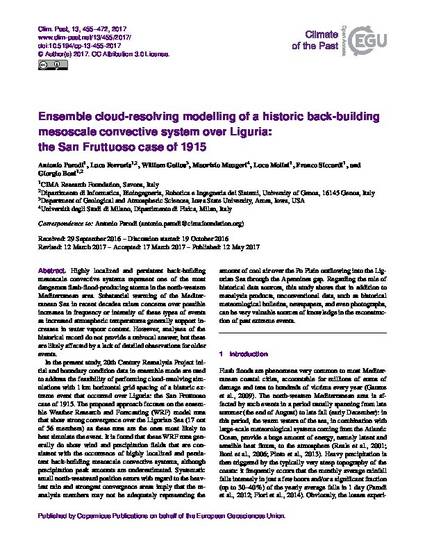
Highly localized and persistent back-building mesoscale convective systems represent one of the most dangerous flash-flood-producing storms in the north-western Mediterranean area. Substantial warming of the Mediterranean Sea in recent decades raises concerns over possible increases in frequency or intensity of these types of events as increased atmospheric temperatures generally support increases in water vapour content. However, analyses of the historical record do not provide a univocal answer, but these are likely affected by a lack of detailed observations for older events.
In the present study, 20th Century Reanalysis Project initial and boundary condition data in ensemble mode are used to address the feasibility of performing cloud-resolving simulations with 1 km horizontal grid spacing of a historic extreme event that occurred over Liguria: the San Fruttuoso case of 1915. The proposed approach focuses on the ensemble Weather Research and Forecasting (WRF) model runs that show strong convergence over the Ligurian Sea (17 out of 56 members) as these runs are the ones most likely to best simulate the event. It is found that these WRF runs generally do show wind and precipitation fields that are consistent with the occurrence of highly localized and persistent back-building mesoscale convective systems, although precipitation peak amounts are underestimated. Systematic small north-westward position errors with regard to the heaviest rain and strongest convergence areas imply that the reanalysis members may not be adequately representing the amount of cool air over the Po Plain outflowing into the Ligurian Sea through the Apennines gap. Regarding the role of historical data sources, this study shows that in addition to reanalysis products, unconventional data, such as historical meteorological bulletins, newspapers, and even photographs, can be very valuable sources of knowledge in the reconstruction of past extreme events.
Available at: http://works.bepress.com/william_gallus/62/

This article is published as Parodi, Antonio, Luca Ferraris, William Gallus, Maurizio Maugeri, Luca Molini, Franco Siccardi, and Giorgio Boni. "Ensemble cloud-resolving modelling of a historic back-building mesoscale convective system over Liguria: the San Fruttuoso case of 1915." Climate of the Past 13, no. 5 (2017): 455. DOI: 10.5194/cp-13-455-2017. Posted with permission.